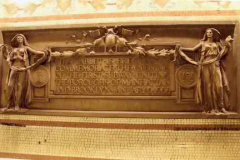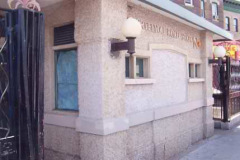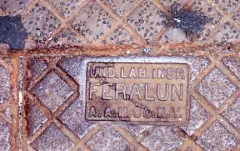My fascination with the NYC subway’s infrastructure continues unabated and my love affair with the subways remains unrequited. That is made clear every weekend, when the MTA runs most lines completely differently than it does during the week. The subways are now over 105 years old (some lines are, at least) and while the sensible notion may be to blow them up and start over, that would run in the trillions and take another century to complete. It has taken 70 years and counting to build a Second Avenue line (while it took about five to build NYC’s original IRT trunk line in the 1900s). I rode the L line to Brooklyn again recently and was amazed by the beauty and complexity of its mosaics. The NYPD allowing (and they don’t, always) I will soon do a special on the Canarsie Line mosaics alone. In the meantime, here’s the completion of a series the MTA’s Gary Fonville started in August 2009 … getting in and on the trains.
LEFT: Central Park has many stations in close proximity. The 2, 3, and F run directly under it at some point along their routes. However, there are only three stations that are IN Central Park. This one’s at Columbus Circle (under contruction in 2009). RIGHT: 5th Avenue & 59th Street, with a unique pair of entrance lamps.
LEFT: Park entrance, 110th & Central Park West. RIGHT: While the IRT and BMT do have mezzanines, the IND took it to the next level. Almost all IND stations have mezzanines such as this one at West 4th Street on the A, B, C, D, E, F and V lines. This was done to accommodate more people than was possible on the BMT and IRT.
A unique feature of the 181st Street station on the A is this suspended walkway above the tracks. RIGHT: The #7 Flushing Line is the only line to run 11-car consists, likely because of its heavy traffic.
Two commemorative plaques on the Brooklyn Boro Hall IRT platform serving #4 and #5 trains to celebrate the institution of subway service from Manhattan to Brooklyn in 1908. This station was thoroughly renovated and restored in the early 1980s.
ABOVE: One can transfer from the 6 or 4 (during midnight hours) to the B,D,F or V. However, there’s a caveat. One cannot transfer from the B,D,F or V to an uptown 6 without leaving the station and walking a block to the Bleecker Street station! The uptown and downtown platforms from the original 1904 construction were not exactly opposite each other. In addition, platforms could then only accommodate five car trains. To increase capacity, management of the IRT decided to lengthen the stations to accommodate ten car trains. The uptown platform was lengthened northward and the southbound platform was lengthened southward.
The southbound lengthening extended to Houston Street where the Independent (IND) Subway would later be constructed in 1936, making possible a free transfer. Since the uptown station was lenghtened northward, the platform still did not reach Houston Street. A tunnel was never constructed to make a free transfer possible.
ABOVE: While the biggest gap in distance between two stations is the Broad Channel and Howard Beach stations, the shortest gap in the system is between Cortelyou Road and Beverl(e)y Road on the B & Q lines in Brooklyn. This dates back to the days of the Brooklyn, Flatbush and Coney Island Railway, the Brighton Line’s predecessor.
Chandeliers in the subway? If you don’t believe it was ever possible, check out the City Hall Station from a downtown 6 train on its turnaround through the City Hall Station before it heads uptown. Only two other stations on the IRT ever had chandeliers. Traces of where they hung them are on the ceiling at the 181st and 168th Stations on the 1. Picture here taken at the 181st Street station. RIGHT: Accommodations for a smaller chandelier is on arc closer to platform level here at 181st Street on the 1.
Old-style token booths. Not too many of these left from the original construction of the IND (Independent Subway). LEFT: Here one sits as if ready for use on the uptown platform at the 50th Street station for the C, E and sometimes A. RIGHT: Ditto for former booth at the Northern Boulevard Station for the R, V and sometimes G.
Two islands located within NYC have one station apiece: Broad Channel (left) and Roosevelt Island (right). Till 1976 a double fare was charged at Broad Channel — you exited the station by dropping in a token.
ABOVE: The Smith-Ninth Street station on the F & G lines†is the subway’s highest station, rising over 90 over the Gowanus Canal. It is only one of two stations of the original IND that is elevated.The 4th Avenue station (the next stop) for the F & G is the other. Smith-9th is slated for a yearlong closure for repairs (as of 2009). The 4th Avenue station was going to be renovated as well, but the project was cancelled (the MTA is in deep debt). RIGHT: The Broadway entrance to the 191st Street Station on the 1. The other entrance is on St. Nicholas Avenue & 191st. Both entrances lead to the deepest station in the subway system. It’s close to 180 feet below St. Nicholas Avenue. Also, this is one of the FEW places where you’ll see an acronym still visible from an old part of the IRT.
LEFT: Due to Manhattan’s sharp change in topography in the northrn part of the borough, this tunnel is absolutely necessary. If not for this tunnel, passengering wanting to enter the 191st Street station would have to walk about two blocks downtown, walk up two steep blocks to St. Nicholas Avenue, THEN walk two blocks northward to 191st Street. As one of the subway’s longest pedestrian tunnels, it extends from Broadway, crossing under Audubon Avenue then over to St. Nicholas and is very welcomed in the community.
RIGHT: Flatbush Avenue on the 2 and 5 is a very unique station. All other terminal stations in the system have the platform in the center of the two tracks. Here’s it’s like a standard station on the rest of the Nostrand Avenue line. This was not intended to be a terminal station originally. The IRT had planned to extend its line along Nostrand Avenue to Sheepshead Bay, but budgetary problems nixed that idea.
A substation that earlier escaped FNY’s camera exists here at 139th Street between Willis and Alexander Avenue; Mott Haven, the Bronx. This substation serviced the 3rd Avenue el when it crossed the East River to Manhattan. RIGHT: A closeup of the building’s plaque.
LEFT: Times Square platform of the Times Square – Grand Central Shuttle, originally part of the 1904 IRT line. It is unable to accommodate a full 10-car consist. RIGHT: Shuttered barbership on the mezzanine level of the Jay Street-Borough Hall Station of the A, C and F lines.
LEFT: The subway’s only direct entrance to a department store. (The 6th Avenue El once opened to the Siegel-Cooper store on 18th Street). This K-Mart was the site of the defunct Wanamaker’s department store: Astor Place station on the 6. RIGHT: There aren’t too many stations that have part of a building extending into the station. The old telephone company building extendings into the Lawrence Street station on the R and M lines in Downtown Brooklyn. A similar feature can be seen on the staircase on the uptown side at 33rd Street on the 6 line from an old armory.
LEFT: Advertising wasn’t in the cards during the planning of the IRT & BMT lines. They were an afterthought, as they were later seen as a source of much needed revenue. The IND planners made accommodations for advertising from the start †by making cutouts in the walls where they could be placed. Sign cutouts like this one can be found throughout the IND System. RIGHT: On the staircase to the St. Lawrence Street station on the 6 line, one sees what may an original feature of this 1920 station.

One of the very few places in the subway system where a station’s entrance is IN a tenement building. Entrance is possible to the A at Dyckman Street, Manhattan here.
ABOVE 2: Most entrances to the subway are done by going down or up a staircase. Here 174-175th Street/Grand Concourse along with the station at Kingsbridge Road on the Concourse line can one enter the subway frombelow and above. The Concourse runs along the top of the Concourse’s subway, while the Cross Bronx Expressway and 174th Street runs below the subway – hence the entrance.
LEFT: One of the largest BMT station houses is at the 9th Avenue station on the D & M. RIGHT: Some distinctive touches are contained in this station. The word NEWS STAND is placed above where a newsstand was in the same manner as MEN and WOMEN was written over the doors of restrooms on the original IRT. (This feature can also be found on the 77th Street station on the 4th Avenue Line in Bay Ridge.)
Touches of Frank Lloyd Wright can be best seen from the inside of the 9th Avenue station. ABOVE RIGHT, LEFT:
It is possible for there to be express service between the Church Avenue and 7th Avenue station on the F line. But there hasn’t been regularly scheduled express/local service between the two stations for many years. Hope is high this this service will be reinstituted.
While most express/local tracks are either next to each other as they are on the Broadway line between 96th Street & 42nd Street or are below the local ones as on the Lexington Avenue line between Grand Central and 103rd Street, express service takes a small detour between the two stations – traveling under Prospect Park for some of the distance.
Photos and text by Gary Fonville
Page completed October 4, 2009






































